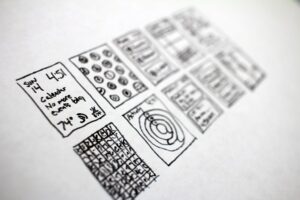In a world saturated with visual stimuli, the art of logo design has evolved significantly over the years. You may have noticed that many brands are gravitating towards minimalist logo designs, which emphasize simplicity and clarity. This trend is not merely a passing fad; it reflects a deeper understanding of how consumers interact with visual elements.
Minimalist logos strip away the unnecessary, allowing the core message of a brand to shine through. As you delve into the realm of minimalist logo design, you will discover how this approach can enhance brand recognition and foster a lasting connection with your audience. Minimalist logo design is characterized by its clean lines, limited color palettes, and an overall sense of balance.
You might find that these logos often convey a sense of sophistication and modernity, making them appealing to a wide range of consumers. By focusing on essential elements, minimalist logos can communicate complex ideas in a straightforward manner. This article will explore the power of simplicity in logo design, the key elements that contribute to minimalist aesthetics, and the importance of negative space, color, and typography in creating effective logos.
Key Takeaways
- Minimalist logo design focuses on simplicity and essential elements to create a clean and impactful visual identity.
- The power of simplicity in logo design lies in its ability to communicate a brand’s message clearly and memorably.
- Elements of minimalist logo design include geometric shapes, clean lines, and minimal use of color and typography.
- Negative space plays a crucial role in minimalist logo design, allowing for clever and creative visual storytelling.
- Color and typography in minimalist logo design should be used sparingly and purposefully to enhance the overall simplicity and impact of the logo.
The Power of Simplicity in Logo Design
Simplicity is a powerful tool in logo design. When you think about it, the most memorable logos are often the simplest ones. A minimalist approach allows you to create designs that are easily recognizable and versatile across various platforms.
You may have noticed that brands like Apple and Nike have logos that are stripped down to their essence, yet they carry immense weight in terms of brand identity. This simplicity not only makes the logos easy to remember but also ensures they remain relevant over time. Moreover, a simple logo can transcend cultural and linguistic barriers.
When you design with minimalism in mind, you create a universal language that resonates with diverse audiences. This is particularly important in today’s global marketplace, where brands seek to connect with consumers from different backgrounds. By focusing on fundamental shapes and concepts, you can craft a logo that speaks to people regardless of their language or culture, enhancing your brand’s reach and impact.
Elements of Minimalist Logo Design

When embarking on your journey to create a minimalist logo, it’s essential to understand the key elements that define this style. First and foremost, you should consider the shapes you use. Geometric forms often play a significant role in minimalist designs, as they convey stability and balance.
You might find that circles represent unity and wholeness, while squares suggest reliability and strength. By thoughtfully selecting shapes that align with your brand’s values, you can create a logo that communicates your message effectively. Another crucial element is the use of space.
In minimalist logo design, every inch counts. You should aim to create a sense of harmony by balancing positive and negative space. This balance not only enhances the visual appeal of your logo but also allows for better legibility.
As you experiment with different layouts, pay attention to how the elements interact with one another. A well-composed logo will draw the viewer’s eye naturally, guiding them through the design without overwhelming them.
The Importance of Negative Space in Minimalist Logo Design
| Article Title | Word Count | Publication Date |
|---|---|---|
| The Importance of Negative Space in Minimalist Logo Design | 1200 | June 15, 2021 |
Negative space is often an underappreciated aspect of minimalist logo design, yet it holds immense potential for creativity and impact. When you utilize negative space effectively, you can create dual meanings or hidden images within your logo. This clever use of space can engage viewers and encourage them to look closer at your design.
For instance, the FedEx logo cleverly incorporates an arrow in the negative space between the “E” and “x,” symbolizing speed and precision. As you explore negative space in your designs, consider how it can enhance your brand’s narrative. By incorporating subtle elements into the background or between letters, you can add depth to your logo without cluttering it.
This technique not only makes your design more intriguing but also reinforces your brand’s message in a sophisticated manner. Remember that negative space is not just an afterthought; it is an integral part of creating a memorable minimalist logo.
Color and Typography in Minimalist Logo Design
Color plays a pivotal role in minimalist logo design, as it can evoke emotions and set the tone for your brand identity. When choosing colors for your logo, consider how they align with your brand’s personality and values. You might opt for a monochromatic palette to convey elegance or use bold colors to express energy and creativity.
The key is to keep it simple; too many colors can detract from the minimalist aesthetic you aim to achieve. Typography is equally important in minimalist logo design. The font you choose should reflect your brand’s character while remaining legible at various sizes.
Sans-serif fonts are often favored in minimalist designs due to their clean lines and modern appearance. However, you should also consider custom typography to create a unique identity for your brand. As you experiment with different fonts, ensure that they complement the overall design without overwhelming it.
Examples of Successful Minimalist Logos

To truly appreciate the impact of minimalist logo design, it’s helpful to look at successful examples from well-known brands. Take the iconic logo of Apple, for instance; its simple apple silhouette with a bite taken out is instantly recognizable worldwide. This design encapsulates innovation and creativity while remaining visually appealing in its simplicity.
Another excellent example is the Nike swoosh, which represents movement and speed with just a single curved line. The swoosh has become synonymous with athleticism and performance, demonstrating how effective minimalist logos can be in conveying powerful messages with minimal elements. As you analyze these logos, consider what makes them successful and how you can apply similar principles to your own designs.
Tips for Creating an Effective Minimalist Logo
Creating an effective minimalist logo requires careful thought and consideration. Start by brainstorming ideas that encapsulate your brand’s essence. You should focus on what makes your brand unique and how you can convey that through simple shapes and colors.
Sketch out multiple concepts before narrowing down your options; this process will help you refine your ideas and discover new possibilities. Once you have a few strong concepts, seek feedback from peers or potential customers. Their insights can provide valuable perspectives on how well your designs communicate your brand message.
Additionally, be open to revisiting your designs based on this feedback; sometimes, simplicity can be achieved through iteration and refinement.
The Future of Minimalist Logo Design
As we look ahead, it’s clear that minimalist logo design will continue to play a significant role in branding strategies across various industries. With the rise of digital platforms and mobile applications, there is an increasing need for logos that are versatile and easily recognizable at smaller sizes. Minimalist designs lend themselves well to this requirement, ensuring that brands remain visible and impactful in an ever-evolving digital landscape.
Moreover, as consumers become more discerning about their choices, brands will need to communicate authenticity and transparency effectively. Minimalist logos can help achieve this by stripping away unnecessary embellishments and focusing on core values. As you navigate the future of branding, consider how embracing minimalism can enhance your brand’s identity while resonating with an audience that values simplicity and clarity.
In conclusion, minimalist logo design is more than just a trend; it represents a fundamental shift in how brands communicate with their audiences. By understanding the power of simplicity, mastering key elements like negative space, color, and typography, and learning from successful examples, you can create logos that stand out in today’s crowded marketplace. As you embark on this creative journey, remember that less truly can be more when it comes to effective branding.
If you are interested in minimalist logo design, you may want to check out Blur&Co’s portfolio on their website. They have a variety of sleek and simple logos that showcase the power of minimalism in branding. One article that you may find interesting is their blog post on the importance of negative space in logo design. You can read more about it here. If you have any questions or would like to discuss a project with Blur&Co, you can contact them here.
FAQs
What is minimalist logo design?
Minimalist logo design is a style of logo that focuses on simplicity and minimalism. It typically uses clean lines, simple shapes, and a limited color palette to create a sleek and modern look.
What are the benefits of minimalist logo design?
Minimalist logo design can help a brand to appear more modern, sophisticated, and timeless. It also tends to be more versatile and easily recognizable, making it easier to use across various platforms and applications.
What are some examples of minimalist logos?
Some well-known examples of minimalist logos include the logos for Nike, Apple, and Google. These logos use simple shapes and clean lines to create a strong and memorable visual identity.
How can I create a minimalist logo for my brand?
To create a minimalist logo for your brand, start by focusing on the core elements of your brand and simplifying them into clean and simple shapes. Use a limited color palette and avoid unnecessary details to achieve a minimalist look.
What are some tips for designing a minimalist logo?
When designing a minimalist logo, it’s important to focus on simplicity, balance, and negative space. Use clean lines and simple shapes, and avoid clutter or unnecessary details. It’s also important to consider how the logo will scale across different sizes and applications.




